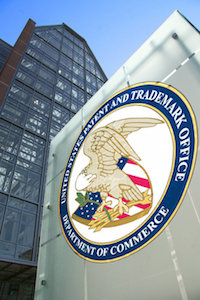“A lawsuit filed against the USPTO’s implementation of the Fintiv discretionary denial framework by major tech companies underscores issues that the agency might face if the new nomination form leads to precedential designations on controversial decisions.”
 In late September, Bloomberg News reported that Scott Boalick, Chief Administrative Patent Judge (APJ) at the Patent Trial and Appeal Board (PTAB), announced the introduction of a new form allowing members of the public the ability to nominate certain PTAB decisions for precedential status. The form, available on the U.S. Patent and Trademark Office’s website, asks those endorsing decisions to choose whether precedential or informative status should be conferred and to provide some brief reasons for the nomination.
In late September, Bloomberg News reported that Scott Boalick, Chief Administrative Patent Judge (APJ) at the Patent Trial and Appeal Board (PTAB), announced the introduction of a new form allowing members of the public the ability to nominate certain PTAB decisions for precedential status. The form, available on the U.S. Patent and Trademark Office’s website, asks those endorsing decisions to choose whether precedential or informative status should be conferred and to provide some brief reasons for the nomination.
As Bloomberg’s coverage suggests, the anonymous nature of the process could encourage nominations from practitioners representing both patent owners and petitioners at the PTAB who may be concerned about how some clients may view their nominations. Such client overlap is a common feature at the PTAB, where many of the most active law firms representing patent owners are also atop the list of most active petitioners’ counsel. Prior to the nomination form, individuals had to make a written request to the Chief APJ within 60 days of the decision being issued to have the decision considered for precedential status.
Iancu Remarks on Increasing Balance in PTAB Trials
On September 25, a day after reports of the nomination form surfaced, USPTO Director Andrei Iancu made remarks at the virtual annual meeting of the PTAB Bar Association discussing changes that have been made to PTAB practice over the past few years. Although no mention was made of the new nomination form, Iancu did discuss successes in reducing pendency for ex parte appeals in the Fast-Track Appeals Pilot Program and training for new PTAB lawyers through the Legal Experience and Advancement Program (LEAP).
Iancu also discussed the agency’s continued focus on efforts to increase balance in PTAB trials that were established by the America Invents Act (AIA), including the popular inter partes review (IPR) proceeding for challenging patent validity. While the 2011 House Report on the AIA indicated that AIA trials “are not to be used as tools of harassment,” Iancu noted that practices developed in the years after the AIA’s passage led to multiple challenges on the validity of the same patent, a practice referred to as serial, or parallel, petitioning. He added:
Such repeated challenges turned certain IPRs from their intended purpose – a cheaper, faster alternative to district court litigation — into the exact opposite – lengthier, more costly, repetitive litigation. Instead of streamlining patent litigation, in other words, some IPRs may lead to additional, prolonged litigation. This is not the bargain struck in the AIA. This is not what Congress intended.
APA Suit Over Fintiv Discretionary Framework Highlights Procedural Rulemaking Issue
One specific type of serial validity challenge being addressed at the PTAB involves instances where an IPR petitioner challenges the validity of patent claims at the PTAB based on substantially the same prior art and invalidity arguments that have been made by the same party in district court infringement cases. Iancu noted that the PTAB’s precedential order in Apple v. Fintiv provides a list of factors that APJs can analyze to determine whether to exercise their discretionary authority under AIA statutes and deny an IPR petition if the district court proceedings are at an advanced stage. “With these factors in mind, we can minimize the ‘repeated litigation and administrative attacks on the validity of a patent’ that Congress warned about, and the PTAB can instead continue to focus on being the faster, cheaper alternative to district court litigation that Congress intended,” Iancu said.
The use of precedential decisions is expected to increase uniformity in decision making at the PTAB, which has been criticized in the past for having an arbitrary and capricious nature. However, a lawsuit filed against the USPTO’s implementation of the Fintiv discretionary denial framework by major tech companies underscores issues that the agency might face if the new nomination form leads to precedential designations on controversial decisions. This August, a group of plaintiffs including Apple, Google, Cisco and Intel filed a lawsuit alleging claims under the Administrative Procedures Act (APA), arguing that Fintiv constitutes a substantive rule that the agency should have been promulgated by notice-and-comment rulemaking. While Iancu framed Fintiv as reflecting Congressional intent that AIA trials wouldn’t be used to harass patent owners, the tech companies argue that Fintiv is actually contrary to Congressional intent behind the AIA. According to Apple and Google, two of the three most active petitioners challenging patent validity at the PTAB, the text and structure of the AIA clearly contemplate that IPRs would proceed parallel to district court litigation and thus “Congress left no room for the Director to otherwise deny a timely IPR petition based on parallel infringement litigation.” Tellingly, intervening in Apple and Google’s APA suit is a group of small business inventors who also want the agency to develop the Fintiv framework through notice-and-comment rulemaking. While the small business inventors, many of whom have faced patent challenges at the PTAB, are seeking a similar result under the APA in terms of rulemaking, they would much prefer that APJs have stronger discretion to deny IPR petitions based on parallel district court proceedings.
Industry Reaction to the Precedential Decision Nomination Form
IPWatchdog reached out to practitioners for input on the nomination form. While most thought it was a good idea, some felt only rulemaking and regulations following public notice-and-comment will truly help to bring about more predictability.
 Dave Cavanaugh, Partner and Chair, Post-Grant Proceedings Group, WilmerHale
Dave Cavanaugh, Partner and Chair, Post-Grant Proceedings Group, WilmerHale
“The form provides a straightforward way to nominate a decision to be designated as precedential. It can help practitioners and other stakeholders assist the Board in identifying cases which could be considered for designation as precedential.
“It is important that a decision which is designated as precedential follow the controlling statutory authority and binding Federal Circuit decisions. Designating a decision as precedential is also not a substitute for formal rulemaking following notice and comment procedures.
“Practitioners and other stakeholders could identify a case for consideration if it: a) presented a recurring fact pattern with, b) robust legal reasoning applying the law to the fact pattern where, c) the outcome is consistent with applicable statutory authority, binding decisions from the Fed. Cir. and fundamental principles like due process.
“Two suggestions I have are:
- “First, there should be an option to nominate a decision to be “Informative.” Informative decisions may assist the Board in developing a consistent body of law without binding particular panels to a particular outcome on a set of facts. Allowing the panels to exercise their own judgement in particular matters may be a suitable way to ensure that the entire body of PTAB judges is engaged in the process of applying the law to particular circumstances.
- “Second, there should be an option in the form to identify a particular decision to be re-designated from ‘precedential’ to either ‘informative’ or ‘routine.’ Designating decisions as precedential may have unintended consequences to the adjudication of patent matters in other cases and in other forums. Without a process for identifying cases for re-designation which is as visible as the nominating form, the Board may be deprived of an understanding of the implications of designating a decision as precedential.”
 Richard M. Bemben, Director, Electronics Practice Group, Sterne Kessler
Richard M. Bemben, Director, Electronics Practice Group, Sterne Kessler
“Under Director Iancu, the USPTO has been very active in seeking to secure and maintain uniformity and predictability in PTAB decisions. Over the last few years, we’ve seen a significant increase in the number of decisions designated precedential or informative, as well as the establishment of the Precedential Opinion Panel. The Office’s recent decision to create a form that can be used for anonymously nominating PTAB decisions to be ruled precedential seems to be a continuation of the Director’s and the Office’s efforts to receive input from its stakeholders as the institution of the PTAB continues to evolve.”

Jim Carmichael, Founder, Carmichael IP and a former administrative patent judge
“The new anonymous nomination procedure is a terrific idea. Otherwise, important decisions might get overlooked merely because no one wanted to submit a nomination that could be attributed to them.

Josh Goldberg, Partner and Leader, PTAB Trials Section, Finnegan
“Practitioners and stakeholders may disagree as to whether particular precedential or informative decisions are good or bad, but the USPTO’s new form removes barriers that previously prevented some from communicating with the USPTO about such decisions.”
 Randy Landreneau, President, US Inventor
Randy Landreneau, President, US Inventor
“Precedential decisions do not have the force of law and do not provide certainty or predictability. This method leaves excessive discretionary decision making up to the administrative patent judges. What is needed for predictability is clear black and white regulations that govern decisions. This will be accomplished through notice-and-comment rulemaking.”

![[IPWatchdog Logo]](https://ipwatchdog.com/wp-content/themes/IPWatchdog%20-%202023/assets/images/temp/logo-small@2x.png)

![[Advertisement]](https://ipwatchdog.com/wp-content/uploads/2024/04/UnitedLex-May-2-2024-sidebar-700x500-1.jpg)
![[Advertisement]](https://ipwatchdog.com/wp-content/uploads/2024/04/Artificial-Intelligence-2024-REPLAY-sidebar-700x500-corrected.jpg)
![[Advertisement]](https://ipwatchdog.com/wp-content/uploads/2024/04/Patent-Litigation-Masters-2024-sidebar-700x500-1.jpg)

![[Advertisement]](https://ipwatchdog.com/wp-content/uploads/2021/12/WEBINAR-336-x-280-px.png)
![[Advertisement]](https://ipwatchdog.com/wp-content/uploads/2021/12/2021-Patent-Practice-on-Demand-recorded-Feb-2021-336-x-280.jpg)
![[Advertisement]](https://ipwatchdog.com/wp-content/uploads/2021/12/Ad-4-The-Invent-Patent-System™.png)






Join the Discussion
3 comments so far.
Pro Say
October 16, 2020 03:51 pmHmm . . . I’m having trouble locating the option to designate claim-cancelling, no-replacement-claims-for-you, innovation-killing, against-Congressional-intent decisions as being unconstitutional . . . given that the “judges” have been illegally appointed to their positions.
Anyone else having this same problem?
p.s. Oh, and by the way; designating unconstitutional decisions as “precedential” or “informative” doesn’t make them any less . . . unconstitutional.
Jam
October 16, 2020 11:17 amNot quite sure how the nomination form would help. Since it is “anonymous” and Internet based, an actor may spam nominations to make every case that invalidates a patent precedential using modern AI to provide “brief reasons” that read human enough. This goes both ways, but it seems like big tech would, again, have the advantage over small inventors.
Anon
October 16, 2020 07:04 amI wonder why the King of ‘Notice and Comment’ (admin law extraordinaire) David Boundy is not on the panel of voices here.